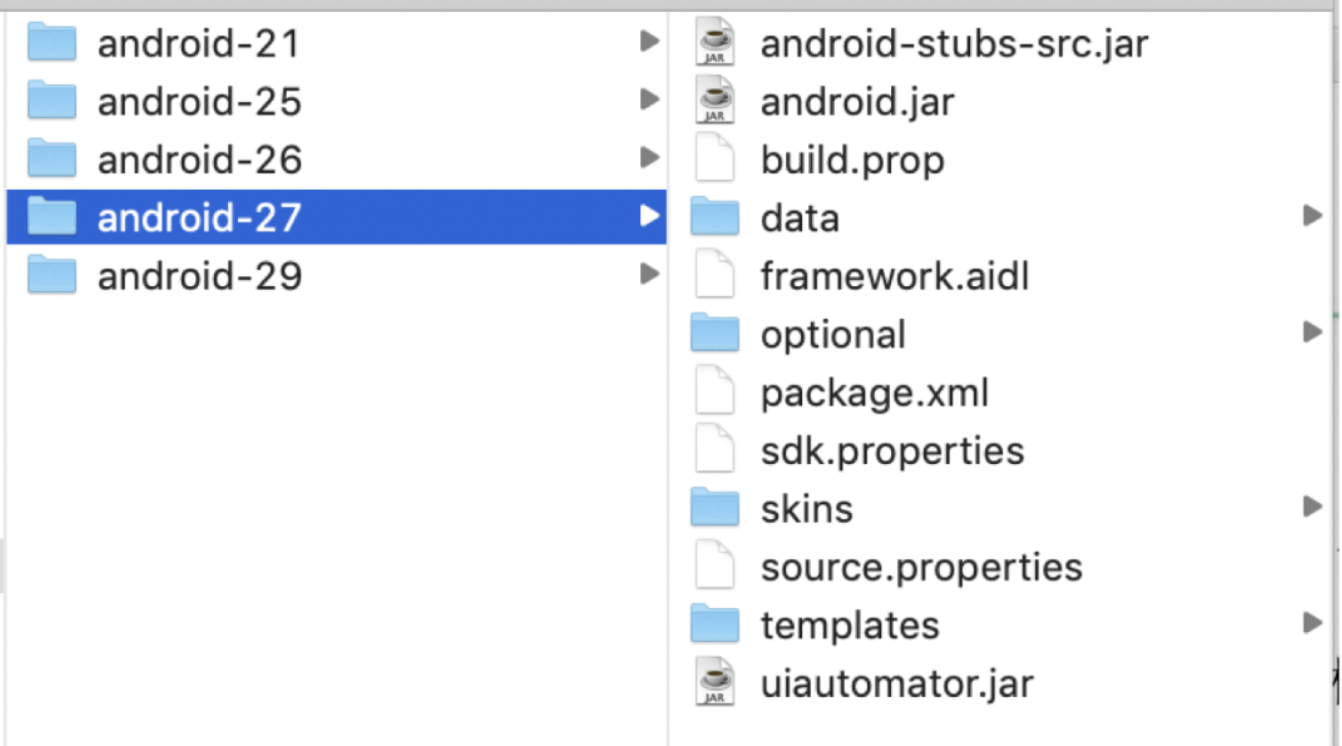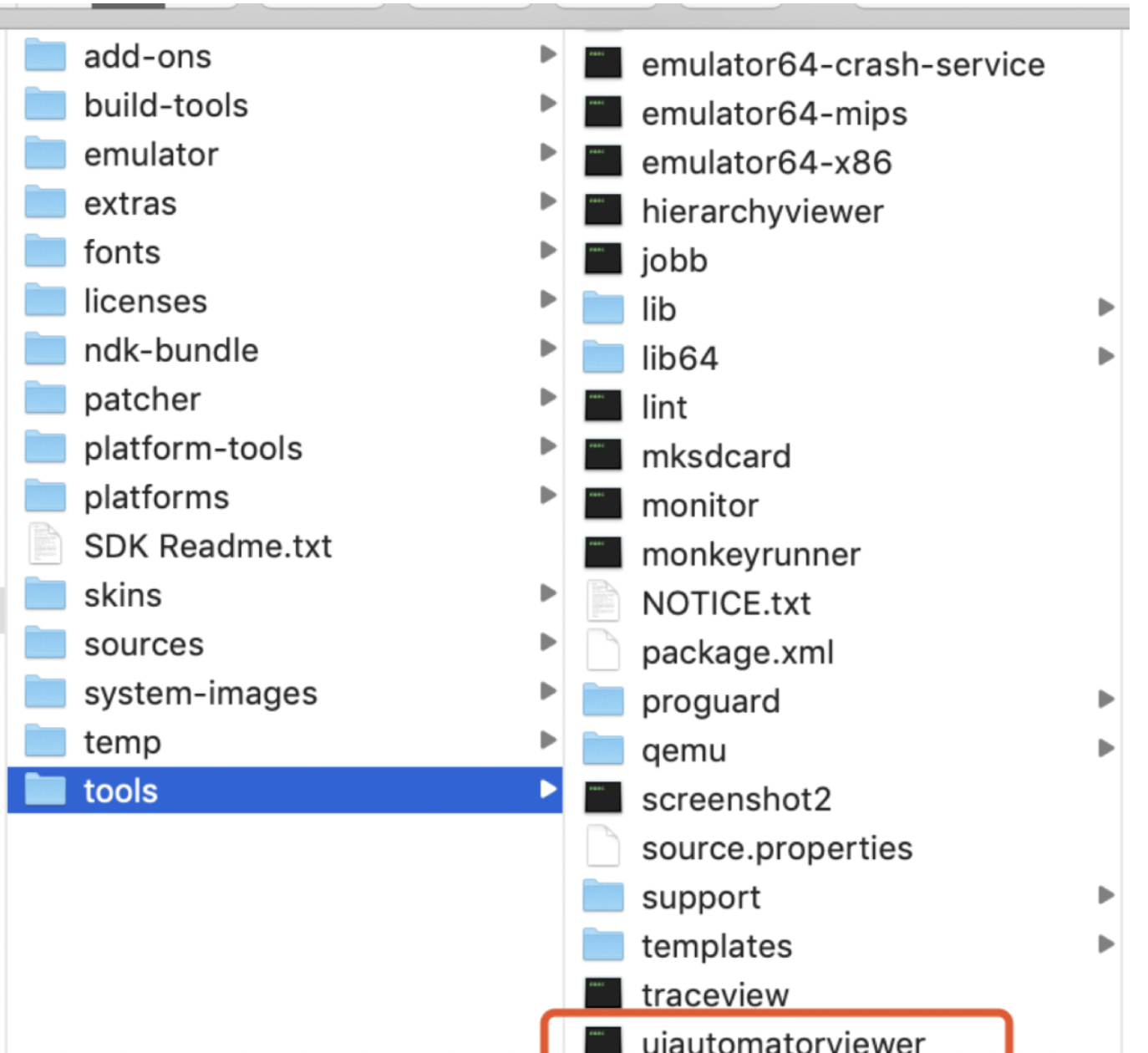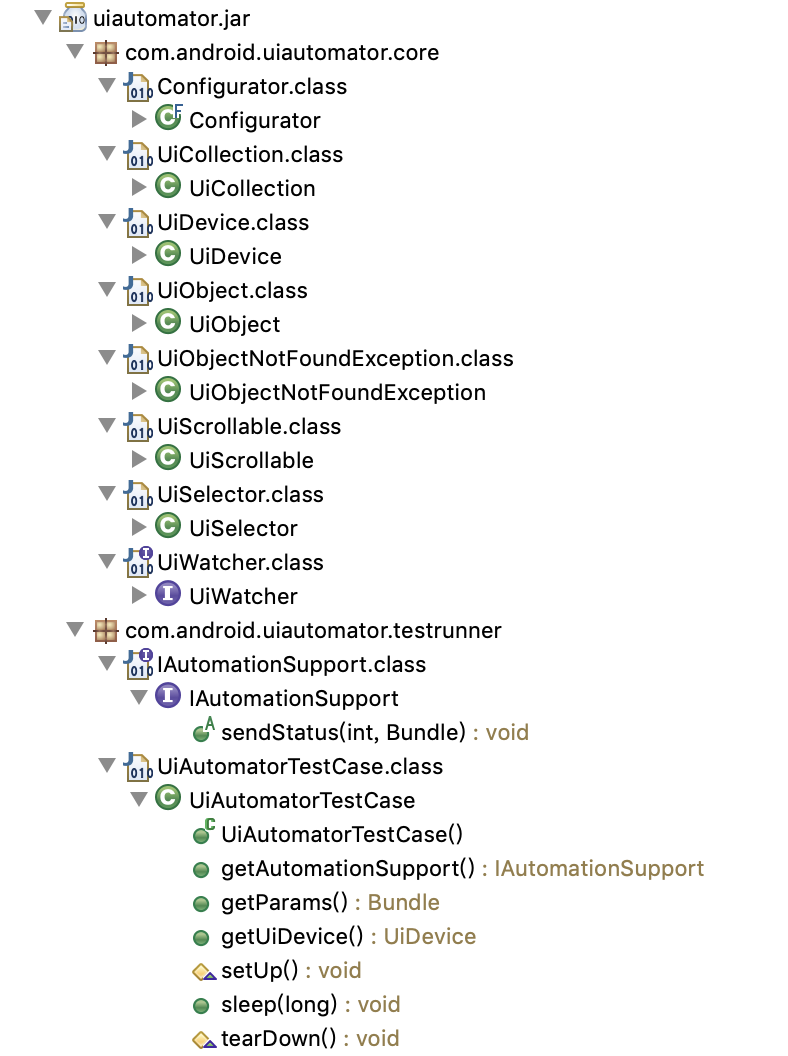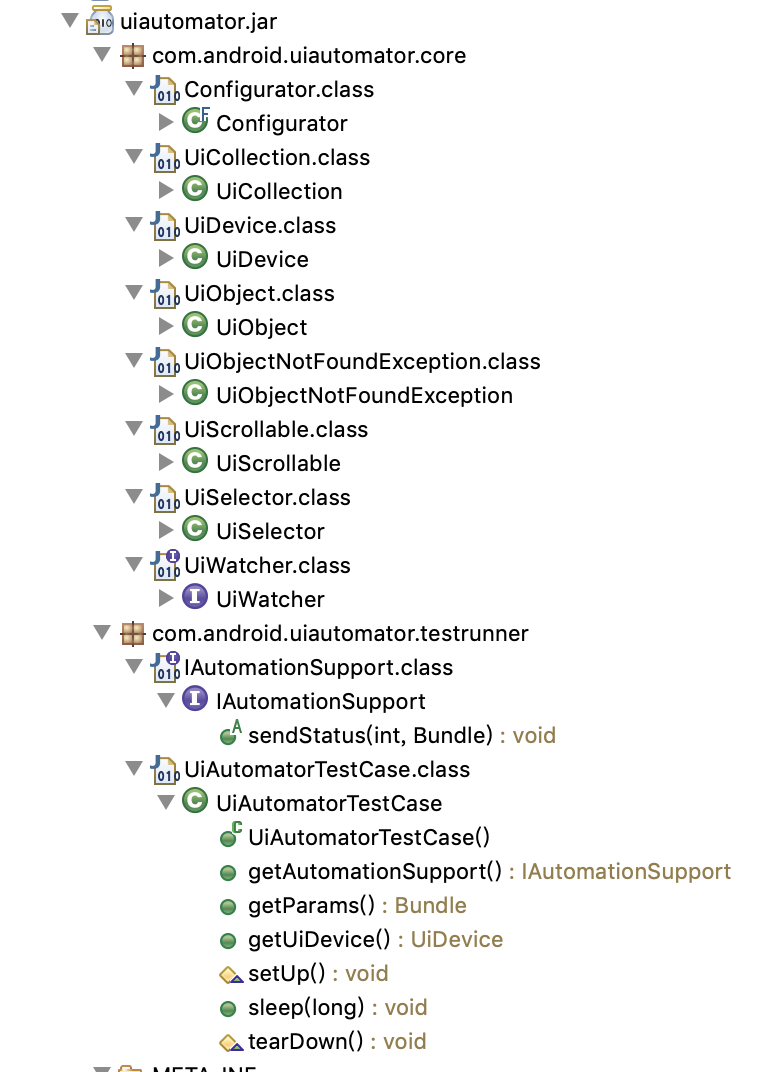Android测试工具 UIAutomator介绍
UI Automator 测试工具定义以及用途
UI Automator 测试框架提供了一组 API,用于构建在用户应用和系统应用上执行交互的界面测试。通过 UI Automator API,您可以执行在测试设备中打开“设置”菜单或应用启动器等操作。UI Automator 测试框架非常适合编写黑盒式自动化测试,此类测试的测试代码不依赖于目标应用的内部实现细节。
优点:可以对所有的操作来进行自动化,操作简单(eg:点击事件 ,侧滑事件,上拉事件,以及模拟键盘输入测试用例)。可以测试所有设备的程序。
缺点:必须要Android4.0以上才能使用。
UI Automator 的执行呢,需要我们编写完毕打成jar包,直接上传到/data/local/tmp/ 目录下面,然后用adb 命令执行即可。由于是安卓原生的,比较稳定,运行的速度也比较快。
我们下载了安卓的环境变量后,然后下载任意大于4.0的安卓版本sdk即可。

都会有这个jar包,我们在写代码,创建工程的时候,直接引入即可。
如何获取定位呢,我们可以uiautomatorviewer。

UI Automator 测试框架的主要功能包括:
用于检查布局层次结构的查看器。
用于检索状态信息并在目标设备上执行操作的 API。
支持跨应用界面测试的 API。
UI Automator 测试框架提供了一个 UiDevice 类,用于在运行目标应用的设备上访问和执行操作。您可以调用其方法以访问设备属性,如当前屏幕方向或显示屏尺寸。UiDevice 类还可用于执行以下操作:
改变设备的旋转。
按硬件键,如“音量调高按钮”。
按返回、主屏幕或菜单按钮。
打开通知栏。
截取当前窗口的屏幕截图。
UI Automator API
通过 UI Automator API,您可以编写可靠的测试,而无需了解目标应用的实现细节。您可以使用这些 API 在多个应用间捕获和操纵界面组件:
UiCollection:枚举容器的界面元素,目的是为了计数,或者按可见文本或内容说明属性来定位子元素。
UiObject:表示设备上可见的界面元素。
UiScrollable:支持搜索可滚动界面容器中的项目。
UiSelector:表示对设备上的一个或多个目标界面元素的查询。
Configurator:可让您设置用于运行 UI Automator 测试的关键参数。
官方文档
https://developer.android.com/reference/androidx/test/uiautomator/package-summary
官方文档有着详细的介绍

正常的我们加入后,在后可以看到,有什么类,方式是什么,里面有什么api。
我们可以在引入后查看。


下面列举几个类的方法
UiDevice
void clearLastTraversedText()
// 清除上次UI遍历的事件 boolean click(int x, int y)
// 根据坐标点击 boolean drag(int startX, int startY, int endX, int endY, int steps)
// 拖动 void dumpWindowHierarchy(File dest)
// dump当前的层次化结构到文件中 void dumpWindowHierarchy(OutputStream out)
// dump当前的层次化结构到流中 void dumpWindowHierarchy(String fileName)
// dump当前的层次化结构到文件中 UiObject2 findObject(BySelector selector)
// 根据BySelector查找 UiObject findObject(UiSelector selector)
// 根据UiSelector 查找 List<UiObject2> findObjects(BySelector selector)
// 根据BySelector查找 void freezeRotation()
// 冻结旋转的状态 String getCurrentActivityName()
// 获取当前Activity的名字,已经被废弃 String getCurrentPackageName()
// 获取当前package int getDisplayHeight()
// Gets the height of the display, in pixels. int getDisplayRotation()
// Returns the current rotation of the display, as defined in Surface Point getDisplaySizeDp()
// Returns the display size in dp (device-independent pixel) The returned display size is adjusted per screen rotation. int getDisplayWidth()
// Gets the width of the display, in pixels. static UiDevice getInstance()
// 获取一个对象 static UiDevice getInstance(Instrumentation instrumentation)
// Retrieves a singleton instance of UiDevice String getLastTraversedText()
// 获取上一次遍历的文本 String getLauncherPackageName()
// 获取运行的packagename String getProductName()
// Retrieves the product name of the device. boolean hasAnyWatcherTriggered() // 检查是否有触发器触发 boolean hasObject(BySelector selector)
// 是否有符合的条件的 boolean hasWatcherTriggered(String watcherName)
// Checks if a specific registered UiWatcher has triggered. boolean isNaturalOrientation()
// Check if the device is in its natural orientation. boolean isScreenOn()
// Checks the power manager if the screen is ON. boolean openNotification()
// Opens the notification shade.
// 打开通知 boolean openQuickSettings()
// 打开设置 <R> R performActionAndWait(Runnable action, EventCondition<R> condition, long timeout)
// Performs the provided action and waits for the condition to be met. boolean pressBack()
// Simulates a short press on the BACK button. boolean pressDPadCenter()
// Simulates a short press on the CENTER button. boolean pressDPadDown()
// Simulates a short press on the DOWN button. boolean pressDPadLeft()
// Simulates a short press on the LEFT button. boolean pressDPadRight()
// Simulates a short press on the RIGHT button. boolean pressDPadUp()
// Simulates a short press on the UP button. boolean pressDelete()
// Simulates a short press on the DELETE key. boolean pressEnter()
// Simulates a short press on the ENTER key. boolean pressHome()
// Simulates a short press on the HOME button. boolean pressKeyCode(int keyCode)
// Simulates a short press using a key code. boolean pressKeyCode(int keyCode, int metaState)
// Simulates a short press using a key code. boolean pressMenu()
// Simulates a short press on the MENU button. boolean pressRecentApps()
// Simulates a short press on the Recent Apps button. boolean pressSearch()
// Simulates a short press on the SEARCH button. void registerWatcher(String name, UiWatcher watcher)
// Registers a UiWatcher to run automatically when the testing framework is unable to find a match using a UiSelector. void removeWatcher(String name)
// Removes a previously registered UiWatcher. void resetWatcherTriggers()
// Resets a UiWatcher that has been triggered. void runWatchers()
// This method forces all registered watchers to run. void setCompressedLayoutHeirarchy(boolean compressed)
// Enables or disables layout hierarchy compression. void setOrientationLeft()
// 设置旋转方向 void setOrientationNatural()
// Simulates orienting the device into its natural orientation and also freezes rotation by disabling the sensors. void setOrientationRight()
// Simulates orienting the device to the right and also freezes rotation by disabling the sensors. void sleep()
// 关闭屏幕 boolean swipe(int startX, int startY, int endX, int endY, int steps)
// Performs a swipe from one coordinate to another using the number of steps to determine smoothness and speed. boolean swipe(Point[] segments, int segmentSteps)
// Performs a swipe between points in the Point array. boolean takeScreenshot(File storePath, float scale, int quality)
// 截屏
boolean takeScreenshot(File storePath)
// Take a screenshot of current window and store it as PNG Default scale of 1.0f (original size) and 90% quality is used The screenshot is adjusted per screen rotation void unfreezeRotation()
// Re-enables the sensors and un-freezes the device rotation allowing its contents to rotate with the device physical rotation. <R> R wait(SearchCondition<R> condition, long timeout)
// Waits for given the condition to be met. void waitForIdle(long timeout)
// Waits for the current application to idle. void waitForIdle()
// Waits for the current application to idle. boolean waitForWindowUpdate(String packageName, long timeout)
// Waits for a window content update event to occur. void wakeUp()
// 点亮屏幕
void clearTextField()
// 清空输入接口 boolean click()
// 点击 boolean clickAndWaitForNewWindow()
// 点击并等待新界面 boolean clickAndWaitForNewWindow(long timeout)
// 点击并等待新界面,设置等待时间 boolean clickBottomRight()
// 点击右下边 boolean clickTopLeft()
// Clicks the top and left corner of the UI element boolean dragTo(UiObject destObj, int steps)
// 拖动 boolean dragTo(int destX, int destY, int steps)
// Drags this object to arbitrary coordinates. boolean exists()
// 判断是否存在 Rect getBounds()
// 返回边界 UiObject getChild(UiSelector selector)
// 根据条件获取子元素 int getChildCount()
// 获取子元素数量 String getClassName()
// 获取当前元素的class name String getContentDescription()
// Reads the content_desc property of the UI element UiObject getFromParent(UiSelector selector)
// Creates a new UiObject for a sibling view or a child of the sibling view, relative to the present UiObject. String getPackageName()
// Reads the view's package property final UiSelector getSelector()
// Debugging helper. String getText()
// Reads the text property of the UI element Rect getVisibleBounds()
// 获取可见边界 boolean isCheckable()
// 是否可以点击 boolean isChecked()
// 是否已经选中 boolean isClickable()
// Checks if the UI element's clickable property is currently true. boolean isEnabled()
// Checks if the UI element's enabled property is currently true. boolean isFocusable()
// Check if the UI element's focusable property is currently true. boolean isFocused()
// Check if the UI element's focused property is currently true boolean isLongClickable()
// Check if the view's long-clickable property is currently true boolean isScrollable()
// Check if the view's scrollable property is currently true boolean isSelected()
// Checks if the UI element's selected property is currently true. boolean longClick()
// 长按 boolean longClickBottomRight()
// Long clicks bottom and right corner of the UI element boolean longClickTopLeft()
// Long clicks on the top and left corner of the UI element boolean performMultiPointerGesture(PointerCoords... touches)
// Performs a multi-touch gesture. boolean performTwoPointerGesture(Point startPoint1, Point startPoint2, Point endPoint1, Point endPoint2, int steps)
// Generates a two-pointer gesture with arbitrary starting and ending points. boolean pinchIn(int percent, int steps)
// Performs a two-pointer gesture, where each pointer moves diagonally toward the other, from the edges to the center of this UiObject . boolean pinchOut(int percent, int steps)
// Performs a two-pointer gesture, where each pointer moves diagonally opposite across the other, from the center out towards the edges of the this UiObject. boolean setText(String text)
// 设置输入内容 boolean swipeDown(int steps)
// Performs the swipe down action on the UiObject. boolean swipeLeft(int steps)
// Performs the swipe left action on the UiObject. boolean swipeRight(int steps)
// Performs the swipe right action on the UiObject. boolean swipeUp(int steps)
// Performs the swipe up action on the UiObject. boolean waitForExists(long timeout)
// Waits a specified length of time for a view to become visible. boolean waitUntilGone(long timeout)
// Waits a specified length of time for a view to become undetectable.
package cn.cool;
import com.android.uiautomator.testrunner.UiAutomatorTestCase;
import android.os.RemoteException;
public class Testone extends UiAutomatorTestCase {
@Override
protected void setUp() throws Exception {
super.setUp();
}
public void testCool() throws RemoteException, InterruptedException {
}
@Override
protected void tearDown() throws Exception {
}
}
Android测试工具 UIAutomator介绍的更多相关文章
- [原创]Android Monkey测试工具使用介绍
[原创]Android Monkey测试工具使用介绍 1 Android Monkey介绍 Monkey是Android中的一个命令行工具,可以运行在模拟器里或实际设备中.它向系统发送伪随机的用户事件 ...
- 2014 非常好用的开源 Android 测试工具
http://www.php100.com/html/it/mobile/2014/1015/7495.html 当前有很大的趋势是转向移动应用平台,Android 是最广泛使用的移动操作系统,201 ...
- 常见Android测试工具简介
在进行android设备测试过程中,在进行系统测试时候,往往需要关注到很多方面,导致一个崩溃或者运行一段时间自动重启或者停止的问题很多.最简单来看,影响因素就有:底层硬件设备.OS层.上层app层.另 ...
- Android 测试工具集01
Appium是一个支持原生,混合和移动web apps的开源的跨平台测试框架工具. ANDROID依赖 Android SDK API >= 17 (Additional features re ...
- 测试工具Wiremock介绍
WireMock是一个开源的测试工具,支持HTTP响应存根.请求验证.代理/拦截.记录和回放.最直接的用法: 为Web/移动应用构建Mock Service 快速创建Web API原型 模拟Web S ...
- monkey测试===Android测试工具Monkey用法简介(转载)
Monkey是Android中的一个命令行工具,可以运行在模拟器里或实际设备中.它向系统发送伪随机的用户事件流(如按键输入.触摸屏输入.手势输入等),实现对正在开发的应用程序进行压力测试.Monkey ...
- Android性能测试工具Emmagee介绍
Emmagee介绍 Emmagee是监控指定被测应用在使用过程中占用机器的CPU.内存.流量资源的性能测试小工具.该工具的优势在于如同windows系统性能监视器类似,它提供的是数据采集的功能,而行为 ...
- Android 测试工具集02
User scenario testing for Android(功能性测试框架) Robotium is an Android test automation framework that has ...
- 【Android测试工具】Android抓包解析全过程
需求原因 在android开发中,遇到socket编程,无法从log日志中查看到与之通讯的socket发送和返回的数据包是什么,这里介绍一个工具,tcpdump工具和wireshark工具查看抓到的内 ...
随机推荐
- SM4密码算法matlab实现
%function C=SM4(X,K,M)%M为1时进行加密,M为0时进行解密操作,X为明文/密文输入,K为密钥输入X='0123456789abcdeffedcba9876543210';%X=' ...
- 2.JAVA自带的序列化反序列化机制
- 二分类问题 - 【老鱼学tensorflow2】
什么是二分类问题? 二分类问题就是最终的结果只有好或坏这样的一个输出. 比如,这是好的,那是坏的.这个就是二分类的问题. 我们以一个电影评论作为例子来进行.我们对某部电影评论的文字内容为好评和差评. ...
- session安全&&CBC字符反转攻击&&hash拓展攻击
session安全 p神写的: 在传统PHP开发中,$_SESSION变量的内容默认会被保存在服务端的一个文件中,通过一个叫"PHPSESSID"的Cookie来区分用户.这类se ...
- PHP序列化与反序列化学习
序列化与反序列化学习 把对象转换为字节序列的过程称为对象的序列化:把字节序列恢复为对象的过程称为对象的反序列化. <?php class UserInfo { public $name = &q ...
- 基于python的webUI自动化-小白基础篇
最近打算研究一下基于python的webUI自动化,先自学了一下相关基础知识,大概用了一个多月的时间,主要是找视频,一边看视频或者文档一边对照着敲代码运行. 重点强调:一定要一边看一边对照着敲代码运行 ...
- mongodb安装教程(亲测有效)
网上太多教程了,都是说的不明不白,所以自己整理一份 #参考官网: https://docs.mongodb.com/manual/tutorial/install-mongodb-on-red-hat ...
- jQurey轮播插件slides简单使用教程
动态演示地址: http://www.zqunyan.com/zgproduction/slidesjs/index.html 简介就不多说了,网上有很多,复制粘贴没意义,会想到用这个插件就代表已经了 ...
- python3 读取写入excel操作-win32com
前面有写一篇是用xlrd操作excel的,这一篇是使用win32com来进行操作excel,个人推荐使用win32com. 要使用win32com组件,也需要先导入win32com包. # -*- c ...
- 不知如何创建UML电路图?看看本文
Visual Paradigm是包含设计共享.线框图和数据库设计新特性的企业项目设计工具.现在你只需要这样单独的一款模型软件 Visual Paradigm就可以完成用UML设计软件,用BPMN去执行 ...
